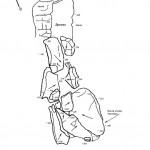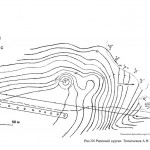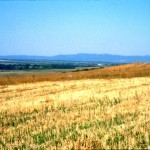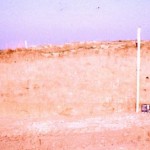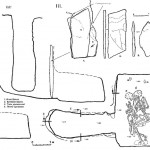The Population of the Steppes
On the Spread of Traditions in the Steppe burial Rite in the Hillfeet of the north-west Caucasus in the middle of Bronze Age
In 2001, by a group of the North Caucasian expedition near the Raevskaya Hillfort investigated a burial mound. The height of the mound as compared to the modern day surface – was approximately 1 m, the diameter of the mound was about 40 m. Until recently the mound was subjected to plowing.
The stratigraphy of the mound was based on two profiles of a mound cut: central and eastern): a buried soil horizon was identified in different parts of the excavation. The most informative, however, turned out to be the central mound cut, which traced the main stages of construction of the mound, stated the fact of the repeated robberies of the mound (mound was cut through by at least three robbery pits). The highest point is marked by zero (Ro), which corresponds to 65,7 m above the sea level. The real height of the mound in the center is 2,5 m.
In the eastern part of the mound an elongated burnt spot size of 0,55×2,1 m, about 0,1 m deep. The intensity of burning is shown by a fairly thick heated loam around. The depth and location of spots relative to the central plundered burial suggest the relationship of these objects. Based on radiocarbon analysis of soil from this spot we received the date of 5690 ‒ to 200 years ago (the age ‒ 6467 years ago: CAL 4779 BC (4518) 4342).
Apart from the central burial №1 in the eastern sector of the mound, had been found four burials: №2 is a collective burial of infants; two burials ‒ №4, 6 ‒ in the form of a «package»; and one ‒ № 7, apparently, a child in the pit in which the burial was burnt, after the burying in the pit there were ordinary oak coals (Quercus robur L) 2 mixed with sandstone rubble.
In the south-southwestern sector of the mound surfaces, 23 m to the south-west of the Ro on the level, close to the level of the original mound of buried soil, they found the bones of the left foot and a piece of a long bone of man, lying right near the plates covering the front pit of the catacomb, very little above the plates level.
The interment was put in the surface of the later mound. Both the entrance to the pit, and a burial chamber of the catacomb had been cut into the rock, formed by the alternation of soft rock of marl and harder sandstone varieties (flysch). The soil of the burial structure cut in the rock, judging by the absense of thick layers of road metal in the mound had been taken out of the monument.
The length of the stone structure, overlapping the entrance pit was about 1,5 m, the slabs of different sizes: more massive were located in the southern part. All the slabs have an incline into the dromos. This may indicate that they had been put on wooden beams. After the wooden part of the ceiling had got rotten, the slabs sunk into the pit entrance.
The input mine is 0,55 m wide near the chamber and 0,7 m on the opposite side 1,8 meter long, it had the direction of NNW-SSE and was filled with a homogeneous dark loam. The entrance to the chamber level of the floor drops: a vertical drop is about 0,3 m. The entrance to the chamber was barred by a massive vertical plate, size 0,6×1,65 m and 0,08‒0,09 m thick. It is put at to 0.3 m off the edge of the burial chamber. On the outside of the locking plate was backed by tiles of irregular shape (dimensions 0,48×1,2 m).
The burial chamber of rectangular shape (size 1.3×2 m) went along the axis of WNW‒ESE. The western and eastern walls of the burial chamber are formed by layers of sandstone rocks. The camera was filled with loam mixed with debris inside the sunken rock. However, the soft rock sample suggests that the chamber height was not less than 1 m high.
On the bottom of the burial tomb a couple – a man and a woman laid. The bones had been crushed by a crumbled vaulted chamber.
The skeleton of the woman (aged 20‒29 years) had been laid along the axis of the chamber in its central part. It laid in a slightly curbed position on the right side with some deviation of thorax and pelvis bones to the back. The head looked WNW. The skull was on the right temple, the front part looked south. The right arm is extended in the direction of the knee, the left one bent at the elbow, the wrist was on the chest. The curb angle in the hip joints is close to the direct one the right leg knee is bent slightly stronger than the left one, the bones crossed. The feet are in a position on the side. In the femoral bones and under the soles the spots of decay are visible.
Pathological changes, including changes in Cribra sockets at the top edge of Cribra orbitalia, are not seen. On the scrapped tibia are visible multiple lines of Harris, whose presence mean multiple stresses of children and adolescents (due to hard starvation or diseases).
The skeleton of the man (aged 20‒24 years) is parallel to the female, it is one a little nearer to the entrance to the chamber. It was a secondary burial of a narrow and long «package» with the elements of a simulated skeleton crouched position with a turn to the left, to the female skeleton. At the western end of the «package» is a skull without a low jaw, laid on the left temple, facing north. In the central part of the «package» there were the ribbons (some of them, apparently, were in the joint), and iliac bones, are over them ‒ the bones of the hands, the shoulder had been laid with its distal ends to the skull. In the eastern part of the package there were bones of the legs. The location of the bones shows that the body of the dead woman originally had been laid in the grave, and only then on her right hand and knee joints had been placed the remains of the man. The man’s soft tissue by the time of burying already had largely decayed. The man’s bones, unlike the woman’s skeleton, had been covered by gray-brown corruptible organic (bag-shroud).
Mandibular third molars did not come out, allowing us to narrow the definition of the limits of the age. In the premolar mandibular one could see the enamel hypoplasia, indicating to the physiological stress at the age of 1,5; 3; 4,5 and 6. In the low jaw there was a crown pulpit of the second molar. Thus, when compared with the size characteristics of the skeleton of the female sexual dimorphism is clearly seen in the structure of the bones of the low limb.
Considering the nature of the burial rite of particular interest in the «package» is the presence of skeletons examination whether the bodies had been tampered. No traces of cuts and other special effects were found, however, this can be attributed to the fragmentary preservation of the bone material.
Along the remote, NE wall of the chamber a strip of wood decay was traced from the board or block, in addition, two spots of decay were found near the western wall (Oak ‒ Quercus L). All this are the traces of a wooden platform on which the litter of brown organic material was placed. The traces could be seen in the legs of the buried woman under the thighs and in the NE corner of the chamber, where they found grave inventory, it included a bronze needle and a pin.
Metallographic examination of the microstructure showed both items are made by forging arsenic brass containing 2.5% Sn. They are of a golden color.
The bronze pin ‒ with a square rod and round in cross-section with a hemispherical pommel-underconic head. The length is not less than 18,5 cm. The cross section of the rod is up to 0,5×0,4 cm. The top length is ‒ up to 2,8 cm. The upper part of the rod is partially 3 cm and covered by the ornaments. The diameter of the neck-intercept (minimum) is 0,3 cm; the head diameter is 1 cm. On each of the four faces there is a line along the axis of the rod, composed of 15 or 16 points of pressure carved by a chisel with a round end. And here on each of the four sides, there are tiny transverse incisions, nicks (about 18‒20, as it could be examined).
The pin is made by an injection followed by rod forging. Between the forgings the rod was heated to a high temperature above 700° C, which led to the disappearance of dendritic segregation, which is usually present in copper-arsenic alloys. Very often in alloys with such treatment due to the corrosion along the grain boundaries we can see intermetallic compound (Cu3As). The same compound covers the surface of the pin itself, and on this compound there is cuprous oxide. Consequently, the pin head is black. In some places in the black nitrous we could see a silver intermetallic compound. Such treatment accompanied by the characteristic corrosion was detected at high Usatovo daggers and daggers in the Maikop culture. According to the hypothesis of N.V. Ryndina, they are of the Mediterranean origin.
The bronze needle 12,8 cm long with a tiny fundiform eyelet on one side. The cross-section is round, sometimes, perhaps, flattened (to 0,2×0,15 cm). The needle is normal for such products, its micronstructure contains traces of dendritic segregation. The dendrites are elongated in the direction of deformation, which indicates a high degree of compression during forging.
Thus a metallographic study showed that the products manufactured by different doers working evidently in various technological traditions.
The published burial mound from Hillfort Rajevkoe is undoubtedly one of the monuments of the Catacomb community in the middle period of the Bronze Age. It is quite unusual, as unusual is the very the fact of finding such a monument in the hillfeet of the North-West Caucasus. A more precise finding of its cultural identity and historical position within the catacomb community becomes difficult due to a small amount and originality of the accompanying inventory. You can only make some observations and comparisons.
The oldest finds of bronze needles with an eye in the Black Sea area are associated mainly with the monuments of the Late Bronze Age (a carcass and synchronous cultures). Existing references in the literature about the discovery of such a needle in the burial pit culture are erroneous and linked with incorrect definition of this cultural complex. Among the early findings we can call around in the cross-section needle of about 3 cm long from the burial 22/11 Krasnogorovka I cemetery on the Low Don, dated to the late Middle and the beginning of the Late Bronze Age, around in the cross-section needle longer than 9 cm but with a broken eye of the burial 2/20 in the Malaya Martynovka cemetery on the Sal river (Zapadnomanychskaya Catacomb culture). The closest analogy is represented among the early discoveries is around in the cross-section needle in a dolmen near Otkhara village in Abkhazia, further it belonged to a bronze pin, although it’s of other species, but in a certain way it’s common with the pin of the Raevski mound.
An exact analogy for the pin of the Raevskaya catacomb has not been found. According to the experts (here we thank for an advice of E.N. Chernykh, L.I. Avilova), the greatest similarity (in the general outline, a massive head and location of the ornament), it shows the so-called Byble type pins, dating to the period of the the middle Bronze Age or the time of the last centuries of the III millennium BC to the 13th, and, perhaps, to the 12th centuries BC. Unlike ours the bibl pins generally have a small hole in the middle of the rod, and different character ornament in rod top.
Referring to the funeral rite here a posture deserves attention of the buried man and possibly a foot belonging to the skeleton, and the stone slab found near. We can not exclude the assumption that the latter could be related to a widespread idea of the magic foot and its print existing in the Upper Paleolith. The increasing complexity of religious beliefs in general led to the formation of the «cult of foot» from the element of hunting magic to one of the central images of sacred symbols.
In the mythology of the population of the Northern Black Sea and the North Caucasus of the Bronze Age the feet had been regarded as the seat of the soul. This, in particular, shows the image of the foot on stone sculptures used as foundation stones in the burial chambers, as well as an image drawn or painted with ocher, done at the bottom and the walls of the burial structures. Much less are facts of limb cutting or the feet themselves. However, in this micro-region the finds of severed limbs near the dromos are known (A.V. Dmitriev excavations in 1994).
Severed or excarnation of skeletons, arranged in a kind of package, sometimes with elements of simulated crouched position, are found in the burial complexes in the steppe cattle and crops of the Black Sea Ciscaucasus in a fairly wide chronological and territorial limits. However, most of these findings come from burials beneath the barrows in late catakomb Baturin Kuban steppe culture. Known are the monuments in behind Kuban, that is close enough to the area of our interest.
It seems that all these parallels point to the nature of the mentioned late catakomb complex. We remind you that the vessel from the destroyed catacomb excavated in the Raevskaye settlement in 1994, was also close to the ceramics of the Baturin Catacomb culture.
(Alexander N. Gay, Aleksey A. Malyshev, Irina G. Ravitch)




